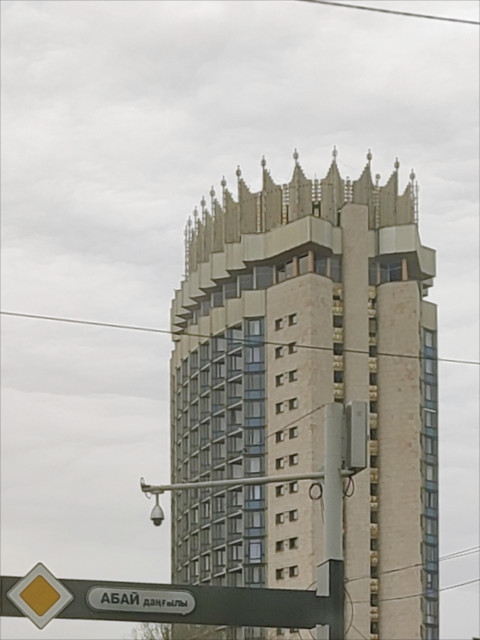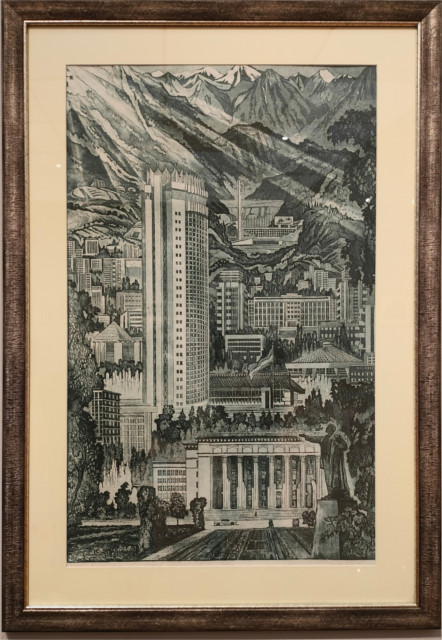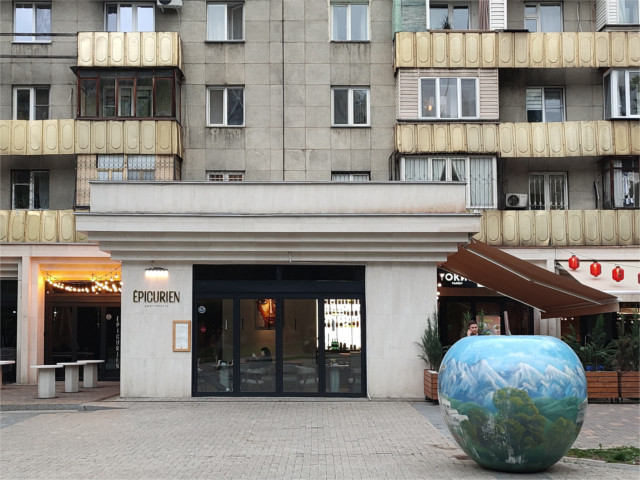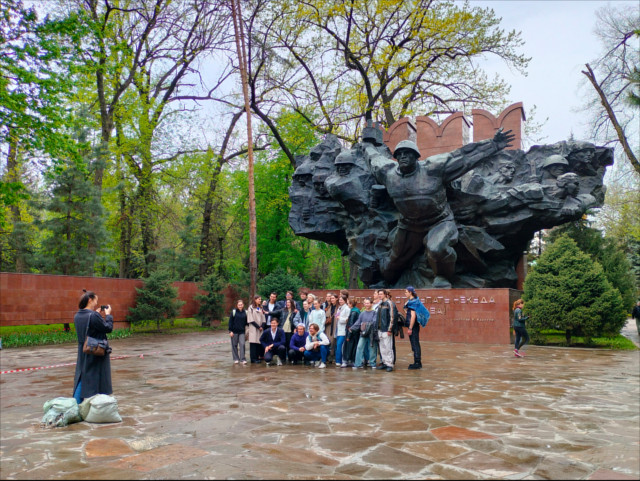Alison Smithson first claimed the words [The New Brutalism] in public as her own in a description of a project for a small house in Soho (Architectural Design, November [sic] 1953) designed before the phrase existed, and previously tagged “The warehouse aesthetic” – a very fair description of what the New Brutalism stood for in its first phase. Of this house, she wrote: “… had this been built, it would have been the first exponent of the New Brutalism in England, as the preamble to the specification shows: ‘It is our intention in this building to have the structure entirely, without interior [sic] finishes wherever practicable. The contractor should aim at a high standard of basic construction, as in a small warehouse.'”
Reyner Banham (in The New Brutalism, 1955)
Louis Kahn is said to have invented the modern steel reinforced concrete structure in 1903. His brother Albert Kahn designed the first buildings with it. Reinforced concrete soon proved to be a revolutionary material: cheap and durable. By 1905 hundreds of new buildings were made with this. In 1929, when the Soviet Union set up its first five-year plan and needed to build large numbers of apartment blocks for its citizens, it invited the Kahns to set up a school of architecture in Moscow. This school is said to have taught over 4000 practicing architects. Later, in the post-war years, when Britain needed to set up inexpensive but large scale construction it reinvented the Soviet style of the 1930s and 40s. This was dubbed The New Brutalism.
… what has caused [Allison Smithson’s project] Hunstanton to lodge in the public’s gullet is the fact that it is almost unique among modern buildings in being made of what it appears to be made of.
Reyner Banham (in The New Brutalism, 1955)
In an insightful essay, the British architectural theorist Reyner Banham defined a Brutalist structure to be “made of what it appears to be made of.” Bare unpainted concrete, was one hallmark. A lack of ornamentation was another. Unremarked by Banham, this was the founding style of post-independence architecture, heavily influenced by Le Corbusier’s and Kahn’s work in Ahmedabad and Chandigarh. I was expecting to meet several examples of Soviet Brutalist architecture in Almaty and marked the examples which were discussed on a map. Usually only one or two buildings in a district are discussed, but it is worthwhile to walk around and discover other examples of such buildings. Putting pins on maps is a good way to trying to guess where such walks are likely to be most fruitful.
In the last resort what characterizes the New Brutalism in architecture as in painting is precisely its brutality, its je-m ‘en-foutisme, its bloody-mindedness. Only one other building conspicuously carries these qualities in the way Hunstanton does, and that is Louis Kahn’s Yale Art Center.
Reyner Banham (in The New Brutalism, 1955)
One was the area just north of Panfilov Park, where I found the building which currently houses the VTB Bank (featured photo), the Almaty Hotel (below) and a monumental office block slowly falling into disrepair (the next below). “What makes them so rectangular?” The Family asked. That gave me pause. Many renowned pieces of Soviet Brutalist architecture (the Kyiv crematorium, or the Kurpaty Resort of Yalta) are not rectangular. I guess rectangles arise in apartment blocks like the one above, when reinforced concrete is made fast and at low cost.
The history of the phrase itself is revealing. Its form is clearly derived from The Architectural Review’s postwar trouvaille “The New Empiricism,” a term which was intended to describe visible tendencies in Scandinavian architecture to diverge from another historical concept “The International Style.” This usage, like any involving the word new, opens up an historical perspective. It postulates that an old empiricism can be identified by the historian, and that the new one can be distinguished from it by methods of historical comparison, which will also distinguish it from a mere “Empirical Revival.” The ability to deal with such fine shades of historical meaning is in itself a measure of our handiness with the historical method today, and the use of the phrases of the form “The New X-ism” – where X equals any adjectival root – became commonplace in the early 1950s in fourth-year studios and other places where architecture is discussed, rather than practiced.
Reyner Banham (in The New Brutalism, 1955)
In popular imagination Soviet Brutalist architecture is from its most expansionist phase: during the 1960s and 70s. But Banham nips this idea in the bud. He points to Khruschev’s delight in twee detailing and his denunciation of the unadorned architectural style of the impoverished but inventive early days of the Soviet Union and asserts that Soviet architecture post-1950s deviated from strict Brutalism. The Almaty Hotel, pictured above, would be an example of this departure: the elaborate non-functional grill would make it quite an illegitimate example of the genre, although the rest of the structure is perfectly Brutalist.
The passion of such discussion has been greatly enhanced by the clarity of its polarization – Communists versus the Rest – and it was somewhere in this vigorous polemic that the term “The New Brutalism” was first coined. It was, in the beginning, a term of Communist abuse, and it was intended to signify the normal vocabulary of Modern Architecture – flat roofs, glass, exposed structure – considered as morally reprehensible deviations from “The New Humanism,” a phrase which means something different in Marxist hands to the meaning which might be expected.
Reyner Banham (in The New Brutalism, 1955)
An office block of this kind is now a dated reminder of the 1960s and 70s, and could have stood anywhere in the world without comment. It is a perfect example of Soviet Brutalism continuing to flourish far from the watchful sight of Moscow. Parts of this and neighbouring buildings have fallen to the artists which find large masses of concrete to be happy canvases for ephemeral street art. I expect that in a year or two this area might become one of the street art districts of the world.
When the stylistic label is attached to art it is very difficult to say with any certainty what is meant by Soviet Brutalism. In most cases, like for the Memorial to Panfilov Regiment in Almaty’s Panfilov Park, I find that the label Socialist Realism may be more appropriate. In this memorial which, despite its questionable history, is a focus of nationalist pride in this new country, the faces of the soldiers are rendered in the Socialist Realist style, more perfect than in reality, and their fearsome grandeur is exaggerated. Perhaps because in common parlance this pose may be confused with being brutal, this monument is sometimes held as an example of Soviet Brutalism. Two mistakes, as so often, takes you further from the correct label, not closer to it.


… there was a certain community of interests, a tendency to look
Reyner Banham (in The New Brutalism, 1955)
toward Le Corbusier, and to be aware of something called le béton brut, to know the quotation which appears at the head of this article and, in the case of the more sophisticated and aesthetically literate, to know of the art brut of Jean Dubuffet and his connection in Paris.
Let me end this with an example of a Brutalist structure which Almaty has taken to heart as its symbol. This is the Hotel Kazakhstan, from the 1970s Brezhnev Era. Our Air Astana flight showed us stunning drone footage of it in their little minute-long introduction to Kazakhstan. I saw it in an etching by the artist Andrey Dyachkin called “My Almaty” in the Central Museum of Kazakhstan in Astana. So I was completely prepared for the sight of the golden crown atop it when we passed by on our way to Kok Tobe.






It is beautiful what humans can create.
LikeLiked by 1 person
So often
LikeLike
Fascinating, IJ! Thanks for sharing. 🙂
LikeLiked by 1 person
Glad you liked this
LikeLiked by 1 person
That is really fascinating and I love all the rectangles, rectangles in rectangles in rectangles.
LikeLiked by 1 person
Thanks. Until the day we all begin to live in Hobbit-holes I guess our doors and windows will give us rectangles in rectangles.
LikeLike
I.J., what a fascinating piece full of history (and rectangles)! This was so informative, as your posts always are. I was not aware of the term Soviet Brutalist architecture, but it now makes perfect sense. Sometimes, in the US, when we see a building that is basically a rectangle, we refer to it as looking like Soviet architecture. Now I know where that comes from. Thanks for such a great post and photos!
LikeLiked by 1 person
Thank you. As you read, the rectangles that are called Soviet are from the Detroit Kahns 🙂
LikeLiked by 1 person
Great info on Brutalism, IJ. It is a distinctive style. A bit “brutal” on the eyes (in my opinion), but always intriguing. But the inside is bright and airy…interesting! I had no idea.
LikeLiked by 1 person
Thank you
LikeLiked by 1 person
Brutalism! The architecture (style? genre? milieu?) that I love to hate. You can’t deny its presence! When you have nothing else to work with, use concrete! Great post.
LikeLiked by 1 person
Thank you
LikeLiked by 1 person
There is a saying here in the US (do you have it there?) “you learn something new every day”. Today your post was my opportunity to learn something new. I must admit I am not a fan of the architectural style but I enjoyed the read and your excellent examples. And quite an abundance of rectangles!!
LikeLiked by 1 person
Yes there is and this week’s topic made me feel that way. I prefer brutalism to Gaudí for sure, and not only because of the rectangles it adds to your life
LikeLike
We have examples of brutalist buildings in Sacramento and Roseville, but they are offices and not homes. I think they are ugly and, of course, not earthquake safe. The buildings here must have been reinforced; although Sacramento is not in an earthquake zone. Your post was very informative and certainly full of rectangles!
LikeLiked by 1 person
Thank you. As I said earlier, there is often a difference between how a flat or office feels like when you use it, against how it looks like from outside. The Brutalist buildings I’ve lived and worked in were light and airy when you were inside.
LikeLiked by 1 person
I’ve learned not to pre-judge anything!
LikeLiked by 1 person
Lots of wow’s
LikeLiked by 2 people
Lots of thanks
LikeLiked by 1 person
Despite its interesting history, I find brutalism rather hard to like, let alone love.
LikeLiked by 1 person
It makes for interesting photos I think. Also, I’ve worked and lived in Brutalist buildings for long times, and they aren’t bad at all (if the architect knows her stuff)
LikeLiked by 1 person
Ah. I’ve rarely had the chance to be inside such a building. Good to know they ‘work’.
LikeLiked by 1 person